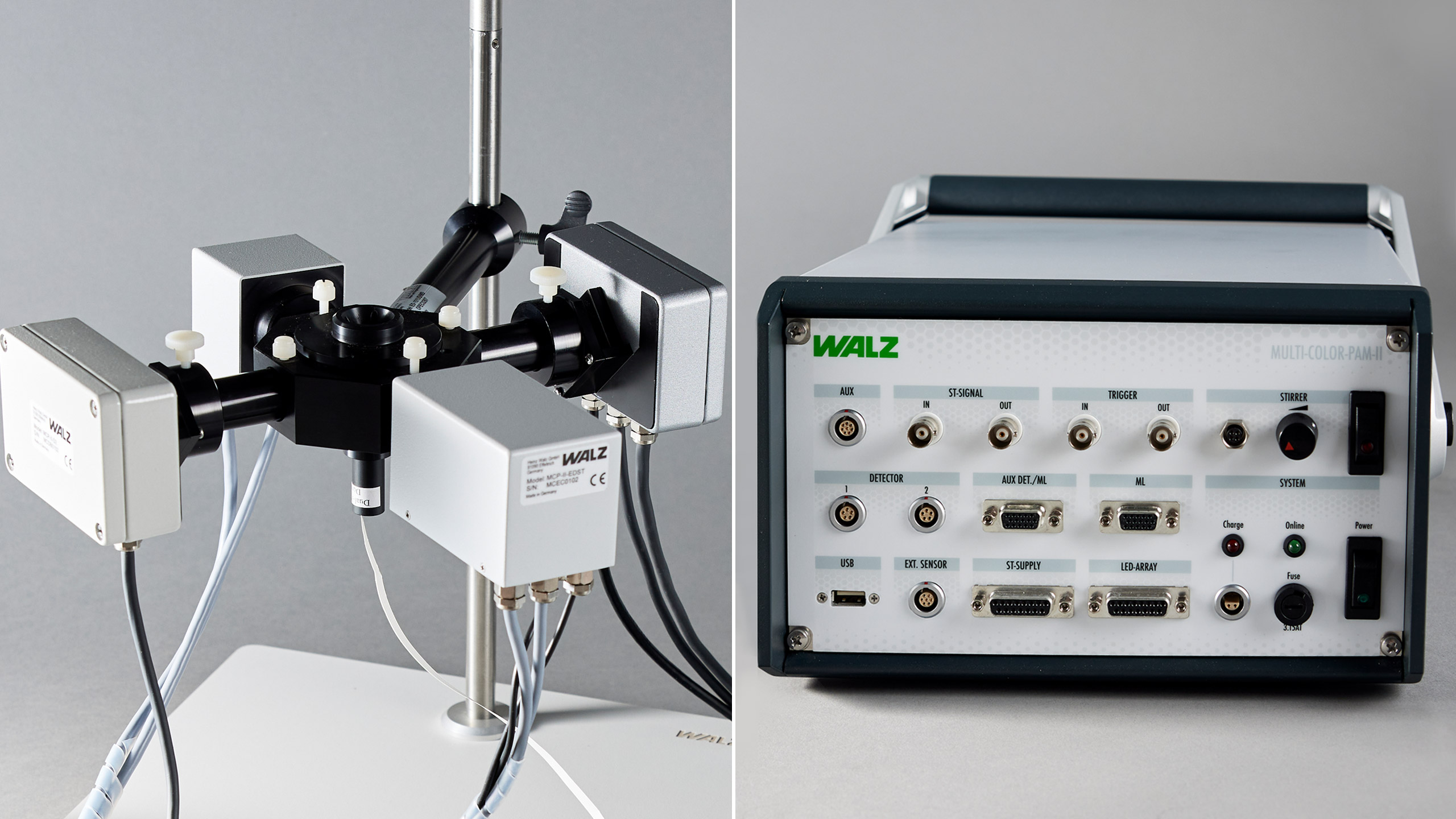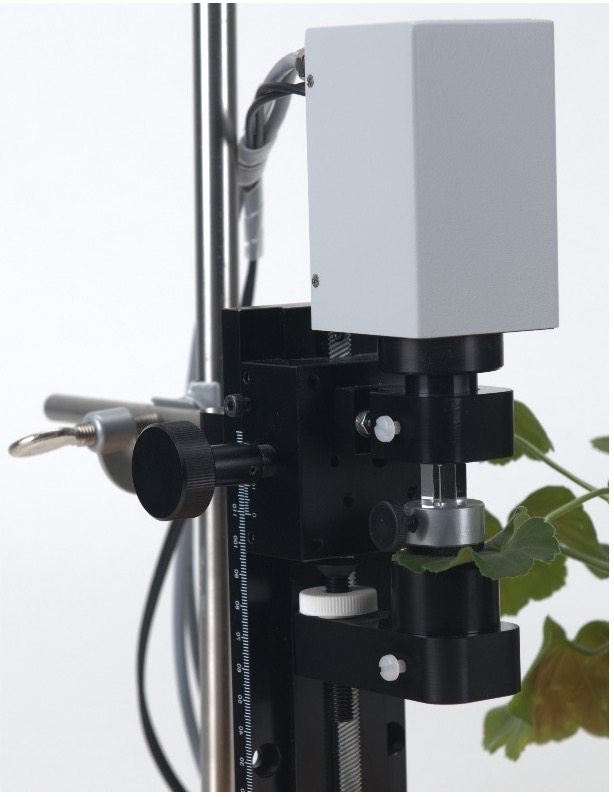MULTI-COLOR-PAM-II
Version:
ST-Kinetics and Multi-Wavelength Chlorophyll Fluorometer

MULTI-COLOR-PAM-II
The new MULTI-COLOR-PAM-II is a compact instrument that houses two quite different techniques: the PAM technique and single turnover flash kinetics (STK).
MULTI-COLOR-PAM-II Highlights
Two instruments in one house: non-modulated flash analysis and multi-color PAM-modulated applications
A complete portfolio of fast measurements (time resolution down to 0.3 µs) to probe the PS II donor side and the presence of Car-triplets and Multi-Color (PAM) measurements to probe the PS II acceptor side, the electron transport chain and photosynthetic activity.
Mixing of both techniques: e.g. application of saturating 3 µs flashes, where the decay kinetics of the induced fluorescence signal can be monitored by PAM measuring light with a logarithmically declining measuring light frequency.
Below an overview of possible applications of both instruments:
PAM
QA-kinetics up to overall Photosynthesis activity
Single Turnover Flash Kinetics (STK)
Oxygen evolving complex up to PQ pool
Pulse-modulated fluorescence
Non-modulated fluorescence
Dark decay measurements
Pump-probe measurements
MT Pulses/continuous light
ST-flashes
Saturation pulse quenching analysis
Saturation flash quenching analysis
Regulatory fluorescence quenching (NPQ) and complementary PS II quantum yields
Short-lived fluorescence quenchers (P680+ (DQ) and Car-triplets (TQ))
Dark-to-light induction curves
ST-kinetics (STK)
Two wavelength detection FV(I)
Period-4 oscillations in FV(II
Fast kinetics (50 µs to seconds) and Slow kinetics (seconds to hours)
Flash train-induced fluorescence changes
Sigma(II) (O-I1 rise)
Sigma(II) (FRRF emulation)
QA– re-oxidation kinetics
S-state decay
PS II quantum yield
S-state distribution
Light saturation curves (LC)
Flash saturation curves
O-I1-I2-P/OJIP transients
Wide range of ST-intensities
PS II heterogeneity
ST-widths and ST-dark intervals
Mixed use of both techniques: e.g., applying an STK during an O-I1-I2-P transient
More choice is an important keyword for the new MULTI-COLOR-PAM-II: the new STK (single turnover kinetics) flashlamp and fast detector add reactions on the PS II donor side and Car triplets to the already broad portfolio. Fast switching between PAM and ST-Kinetics measurements gives synergy, offering a mixing of both techniques. The instrument is also flexible enough to emulate FRRF-type measurements or to produce Ramp-Method-type saturation pulses.
The instrument was designed for the measurement of suspensions, but people working with leaves were also not forgotten. The previous model had a leaf clip that can still be used for the new instrument. In addition, the STK-flashlamp also has a detector and can be used as a stand-alone application for leaf measurements.

Possible configurations:
- The Multi-Color (PAM) configuration: the multi-color-emitter (MCP-II-E) and its detector (MCP-II-D1 or MCP-II-D2ST)
- Two Wavelength Detection (PAM) configuration (suspensions): a second detector (either MCP-II-D1 or MCP-II-D2ST) is added to allow the detection of fluorescence at e.g. < 710 nm (mainly PS II) and > 700 nm (PS II + PS I), simultaneously. A leaf clip allowing two wavelength detection will be available in the near future.
- Full configuration: STK-flashlamp (maximal flash intensities > 1.0 mol photons m-2 s-1) and combi-detector (MCP-II-EDST + MCP-II-D2ST) allowing detection of signals down to approx. 100 ns are added to the Multi-Color (PAM) configuration. This gives access to PS II donor side reactions.
- Single Turnover Kinetics (STK) configuration for suspension measurements: STK-flashlamp (MCP-II-EDST) in combination with the combi-detector (MCP-II-D2ST).
- Single Turnover Kinetics (STK) configuration for leaf measurements: The STK-flashlamp as stand-alone application: the STK-flashlamp contains a detector for fluorescence measurements from the sample surface, which makes it ideal for the measurement of leaves.
In the Multi-Color (PAM) configuration, the user has access to information about the wavelength dependent effective PS II antenna size: Sigma(II), reactions on the PS II acceptor side (QA– re-oxidation) and electron flow along the electron transport chain (O-I1-I2-P/OJIP transients) but also to Saturation Pulse quenching analysis, dark-light induction and recovery curves, as well as light response curves, and this all for 5 different excitation and measuring light wavelengths (440, 480, 540, 590, 625 nm) plus white light that can be applied in any combination. This has the advantage that someone working, e.g., with diatoms can excite these organisms in the green and in the case of cyanobacteria either choose 625 nm to excite the phycobilisomes or 440 nm to excite the chlorophylls of the core antenna.
Not only the different wavelengths for fluorescence excitation and detection make the Multi-Color (PAM) configuration stand out. Other important features are:
- The high sensitivity of the instrument, which allows measurements with optically thin samples, i.e., in the absence of intensity gradients of the various light qualities and largely avoiding wavelength-dependent fluorescence reabsorption – light gradient free.
- Free choice of detection wavelengths using optical filters, e.g., enabling detection of fluorescence >700 nm, enriched in PS I fluorescence F(I), and < 710 nm, enriched in PS II fluorescence F(II), that can be measured simultaneously under equal conditions.
- Characterization of the same state of a given sample by comparative PAM and flash kinetics (STK) measurements.
The almost complete freedom to create trigger and script files means that the experiments that can be designed are mainly limited by the creativity of the user.
New features of the MULTI-COLOR-PAM-II
The new elements of the MULTI-COLOR-PAM-II add whole new domains to the measurement portfolio of the instrument, making it even more a multi-function fluorometer.
- High time resolution: The new STK-detectors provide a time resolution of 0.3 µs.
- Time-resolved flash responses: the MULTI-COLOR-PAM-II is the first commercially available instrument with which the fluorescence yield during a saturating µs flash can be measured and carotenoid triplet quenching (TQ) and donor-side dependent quenching (DQ) can be differentiated.
- Highly precise: For detailed analysis of the flash responses their timing is very precise and reproducible, and the form of the flashes approaches a rectangle, with the LEDs needing about 0.5 µs to reach full intensity. A special routine is provided for flash-profile correction.
- Extremely intense flashes: Flash intensities of more than 1000000 µmol 440 nm photons m-2 s-1 can be achieved with the EDST emitter-detector unit (yielding more than 1 excitation per µs).
Pump-probe: Double flash experiments with variable dark intervals ∆t (from 1 µs to 10 ms) allowing highly flexible relaxation measurements of various forms of quenching. - Period-4 oscillations: Flash frequencies of up to 100 Hz (10 ms time interval) can be used for flash trains to probe the S-states of the oxygen evolving complex.
- Leaf measurements: Although the instrument was originally designed for suspension measurements, the EDST emitter-detector (STK-flashlamp) unit can also be used by itself to measure leaves. In addition, a configuration will be available soon in which two emitters are placed under a 45° angle relative to the multi-color emitter, which allows two wavelength detection of fluorescence emitted by leaves.
- STK embedded in PAM recording: Thanks to fast switching [8-10 µs switching time] between fast non-modulated and PAM measurements an ST can be placed anywhere along a traditional – e.g. O-I1-I2-P or Slow Kinetics recording, with the resulting STK revealing details on the state of PS II at the moment of the flash. All this taken together makes the MULTI-COLOR-PAM-II a very all-round fluorometer allowing the user to probe and monitor PS II and the photosynthetic electron transport chain in many different ways.